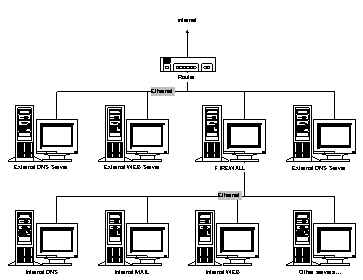
Many corporations today are wanting to connect their internal networks to the Internet to provide access to these external resources to employees who need them to accomplish their assigned tasks. Although this is a very important capability, it is one that must be well planned to avoid possible data security risk from exposing the internal network to users outside the corporation. One common way to provide this protection is with the use of a firewall. In Internet terms, a firewall is a system or device which provides network security by allowing only certain authorized activities to be accomplished between internal networks and the Internet.
A firewall system can be very simple or extremely complex depending on the particular requirements of the individual company. This paper is not designed to provide an exhaustive description of firewall design but we will briefly discuss how the Microsoft DNS server can be used in a firewall environment.
Here is a typical Internet connectivity setup for a company using a dual-homed firewall (that is proxy).

The firewall protects access from the outside while allowing clients on the internal network access to Internet resources. This design also allows for external WWW and FTP servers. These external servers must be closely monitored and secured as much as possible since they are directly on the Internet network with no "firewall" type access control. The router can provide some security by providing packet filtering, if desired, to limit the type of traffic allowed. Access to the internal network is controlled by the firewall.
The internal Web server can be setup exactly like the external server except that security concerns are limited to the access controls necessary for company employees. Typically, only those responsible for Web development will actually logon to the internal servers to change the files located there, although everyone would typically be given the right to view the Web pages using a browser.
The Domain Name System for the external and internal networks are usually entirely isolated from one another. This prevents external clients from obtaining the names and addresses for internal resources located inside the firewall. The only thing an outside user will see is the IP addresses of the servers which are providing external services (that is FTP, www, mail, and so on).